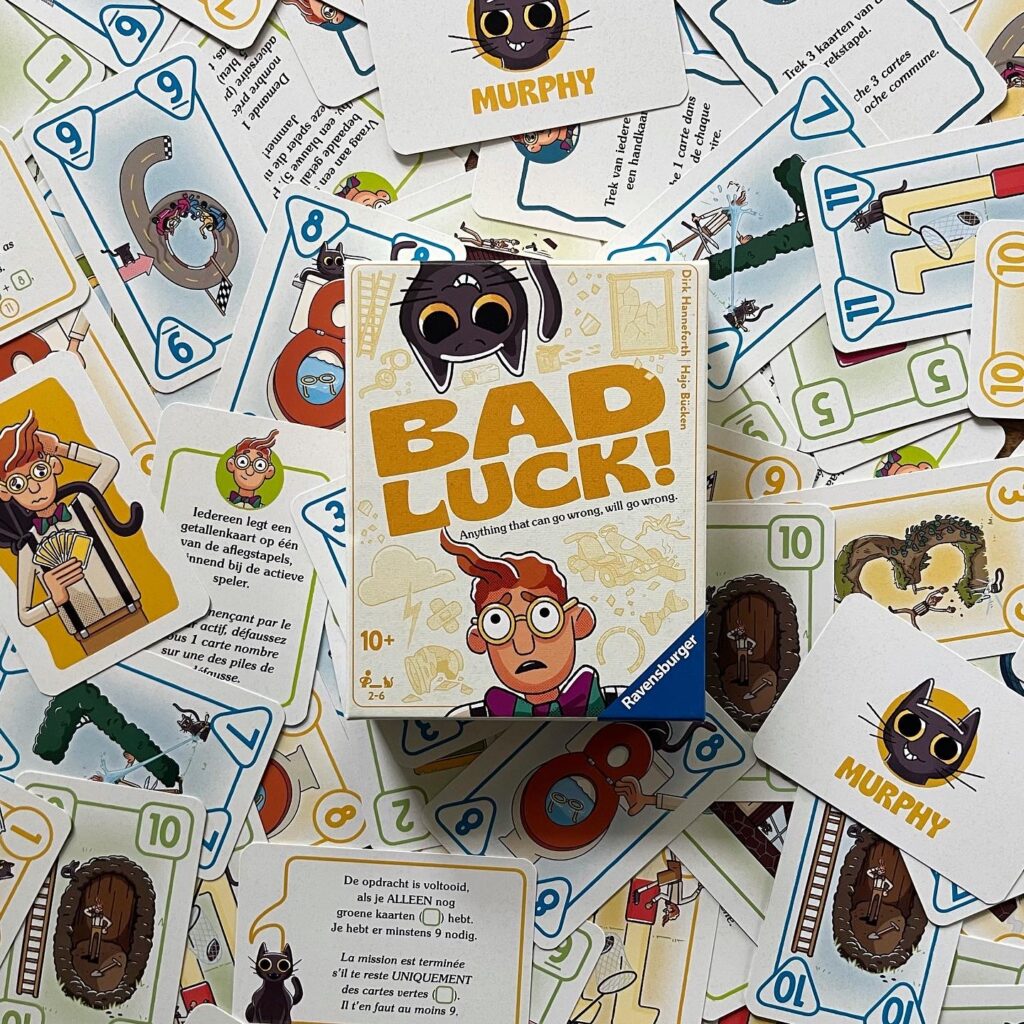Misfortune, bad luck, calamity, mischief and disaster. If it’s up to Murphy and his law, things are bound to go wrong and you’ll be saddled with a lot of Bad Luck.
Background
You may remember the Bad Luck Brian meme: a red-haired boy with braces wearing old-fashioned clothes with whom all sorts of things went wrong. The various macro images with text where Brian was placed in unfortunate situations were the top kind of humor for many Internet goers more than a decade ago. You would almost think that the game Bad Luck would be about this red-headed unlucky guy, but nothing could be further from the truth.

Yes, there is a boy with red hair in Bad Luck, but his name is Mac and I rather picture him with a four-leaf clover and not because of his Irish name. After all, Mac cannot lose and is playing this game for fun. The players can lose (or win, but that is less common) and that is entirely down to Murphy. Both Murphy’s Law and the black cat of the same name.
Murphy’s Law (after many translations and retellings) can be summarized roughly as follows, “everything that can go wrong will go wrong” and is invoked especially when a series of unfortunate events follow one another. That is also somewhat the principle of this card game published by Ravensburger games that first released in German in 1998.
Goal and game design
At the beginning of the game, each player receives a Murphy card. Murphy is the star of the game. On each Murphy card Staten goal. For example: you may only have cards in a specific color and you must have at least a certain amount of cards on had. The first player to complete three of these tasks wins Bad Luck.
In addition to a Murphy cards, players also get a hand of number cards. The first player gets 8 cards and each subsequent player gets and card more. There is also a fictional player named Mac. This lucky player can have up to 7 cards on “hand” (although these cards are just open in front of him on the table). At the beginning of the game, Mac is dealt a number of cards in front of him. Facing Mac and his cards is the draw pile, and next to the draw pile are also two discard piles. Each discard pile starts with an open card.
Gameplay
In addition to Murphy’s Law, bad luck has an additional rule: the 1-2 or 2-1 rule. Each turn you either switch with Mac or with the piles. You first take 1 or 2 card(s) from one of these “areas” and then you place 2 or 1 card(s) back, respectively.
There are number cards and action cards. If you draw a blue action card, you must immediately perform the action. Green action cards can be used during your turn instead of the 1-2/2-1 action.


If you manage to complete an assignment during your turn (where only the number cards count) you let the other players know. You turn over the Murphy card, show your cards, and all the other players must discard their current assignment: tough luck if you were well on your way to completing it. Each player gets a new assignment from Murphy and the game continues.
Conclusion
Some assignments seem impossible and the game is full of take that actions. Because of this, the game is largely about luck and frustration. With action cards you can bully opponents quite a bit, by discarding or taking certain numbers you can frustrate an opponent, and by completing an assignment other players may have saved for nothing. Be prepared for a good dose of bad luck and if you can’t handle this very well, keep this in mind before you try this game.
Bad Luck is therefore particularly suitable for players who just want to play cards and don’t take the gameplay too seriously. Think also of Exploding Kittens or other ‘ take that’-like games. Bad Luck and Murphy do live up to their name and the illustrations are cute and entertaining.



